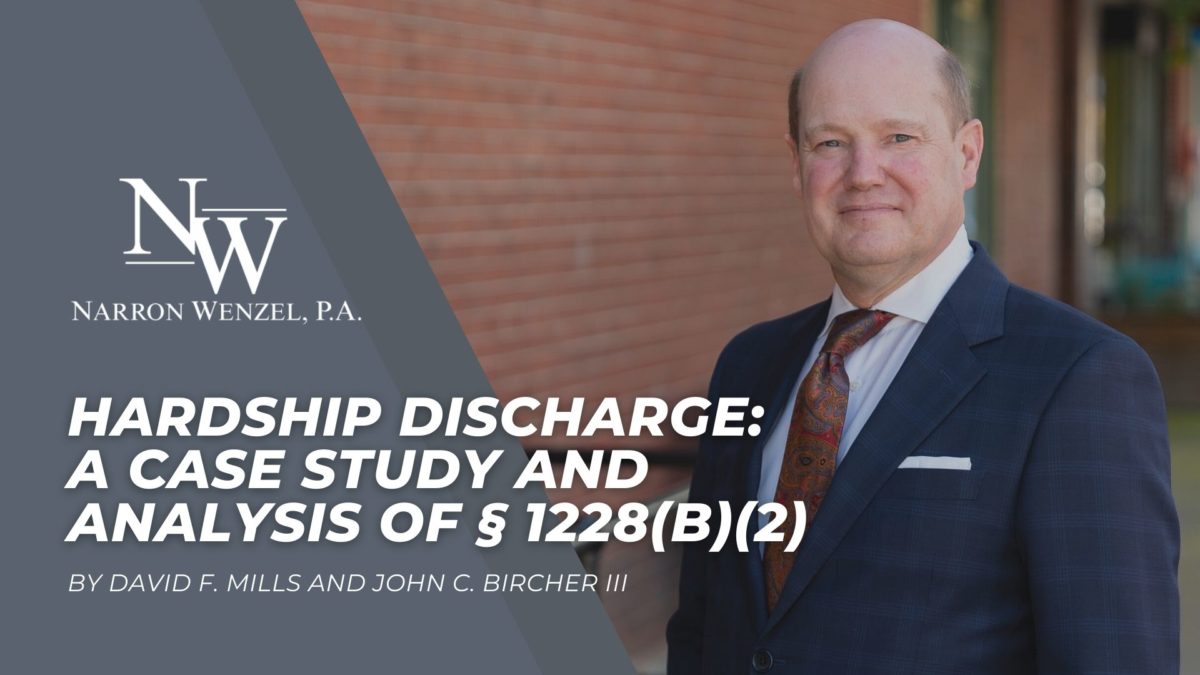
David Mills featured in American Bankruptcy Institute Journal: “Hardship Discharge: A Case Study and Analysis of § 1228(b)(2)”
This article originally appeared in the May 2022 Issue of the American Bankruptcy Institute:
By David F. Mills and John C. Bircher III
“[F]arming is a tough business. Farmers are at the mercy of nature and uncontrollable events. Hurricanes, drought, extreme heat waves, crop blight, international trade wars, and global pandemics relentlessly attack the farming economy. If these risks are combined with a random act of senseless violence resulting in severe bodily injuries on a farmer, the struggle becomes insurmountable.” 1
No truer words could have been spoken about the life and times of one chapter 12 debtor. Despite debilitating bodily injuries, David W. Rouse was denied a hardship discharge because he had not paid his unsecured creditors the amount required by the confirmed plan to be paid pursuant to the “liquidation test.”2 While this article addresses why the authors believe the decision to be erroneous, the primary purpose of this article is to suggest an appropriate framework for the analysis of hardship-discharge motions. Since the hardship-discharge requirements are identical in chapters 11, 12 and 13, the importance of this analysis goes far beyond chapter 12.
June 27, 2020, was a typical evening in Orrum, N.C. The day’s work had ended, but like most farmers in the coastal plain region of the state, Rouse still faced more work once the day’s chores were complete. As farmers know all too well, there are always three or four more tasks to complete in order to do what you planned to get done on any given day. Around 7 p.m. in the cool of the evening, Rouse, a farmer in Robeson County, was completing some tasks when a deranged man appeared and shot him multiple times. The man went on to shoot and kill two other people, and ultimately took his own life that day.3
The shotgun blasts left Rouse seriously debilitated, with significant wounds to his upper body. He lost a finger and suffered other lingering injuries, including nerve damage, muscle damage and vascular damage, all resulting in limited use of his arms and the loss of fine dexterity in his hands. He underwent numerous surgeries and extensive physical therapy. This event effectively ended Rouse’s ability to farm and complete his chapter 12 plan.
Random acts of violence in our society are unfortunately all too familiar. Each one takes its toll on the survivors. When the survivor is also a farmer in an active chapter 12 case, the toll can be overwhelming to his career and his case.
Rouse’s chapter 12 reorganization plan was confirmed on May 23, 2017,4 after significant negotiation of terms between the debtor and the largest unsecured creditor over the course of a few months. The creditor, Nutrien Ag Solutions Inc., had an allowed claim of nearly $950,000.
As a result of these negotiations between the debtor, Nutrien and the chapter 12 trustee, the parties agreed to modify the liquidation-test calculation, resulting in a roughly $9,000 increase in required payments to the trustee to satisfy the “best interests” test found in 11 U.S.C. § 1225 (a) (4). In at least partial consideration of this increase, Nutrien withdrew its opposition to confirmation, and the U.S. Bankruptcy Court for the Eastern District of North Carolina confirmed the plan by consent. Section 1225 (b) (4) requires that the value, as of the effective date of the plan, of property to be distributed under the plan on account of each allowed unsecured claim is not less than the amount that would be paid on such claim if the estate of the debtor were liquidated under chapter 7 of this title on such date.
The negotiated and consensual confirmed plan required Rouse to pay $50,687 pursuant to the liquidation test over the life of the plan. The confirmed plan further stated that it “shall continue until the completion of payments under the Liquidation Test and payment of administrative claims … and at that time the Court may enter a discharge.”5
Since the shooting occurred prior to Rouse’s completion of payments under the confirmed plan, he had two options to consider: convert to chapter 7, or move for a “hardship discharge” under 11 U.S.C. § 1228 (b). The considerations included the debtor’s desire to retain assets, the extent of the discharge available with each option, tax issues and the existence of post-petition debt. The debtor decided to pursue a hardship discharge. Section 1228 (b) states, in part, that…
